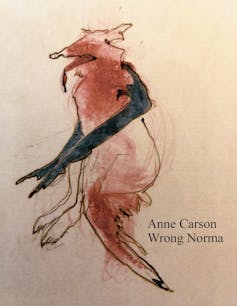Flawed Normathe latest assortment of writings (and drawings and facsimiles) by the feted Canadian poet Anne Carsonis a bit full of allusions, quotations, references, parody and various kinds of stylised evocation.
Typically the allusions are further buried than a quick Google permits for. The opening piece 1=1, as an illustration, is a meditation on (amongst completely different points) swimming. Whereas considering all the swimmable our our bodies of water that are not being swum in, the narrator eccentrically asserts:
One after the opposite or , geographically or conceptually, putting aside gleaming Burt Lancaster, any individual must be using all that water.
Out of context, with its campy essential tone and reference to a mid-century movie star, this would possibly almost be from a poem by the New York poet Frank O'Hara. Nevertheless the narrator of 1=1 quickly strikes on to a further updated concern: “refugees in a makeshift plastic boat” – actually certainly one of numerous references in Flawed Norma to political, ethical or approved points.
Analysis: Flawed Norma – Anne Carson (Jonathan Cape)
Nevertheless what of Burt Lancaster, whose presence seems enigmatic compared with the morally urgent maritime asylum seekers?
Lancaster carried out the lead perform in The Swimmer (1968), an adaptation of a story by John Cheeverwhereby the protagonist seeks to “swim residence” all through the yard swimming swimming pools of well-heeled Connecticut. This quasi-surrealist conceit, which brings collectively the precise and the gently implausible, is an appropriate allusion for Carson’s e ebook, which moreover inhabits the liminal areas between regularly actuality and the extra-rational lessons writers guests in: the lyrical, the surreal, the absurd, and so forth.

On the hazard of freighting a fleeting reference with undue significance, The Swimmer – a film regarding the lack of romantic and social bonds – moreover seems thematically apposite for Flawed Norma, as each bit inside the assortment is nervous with connection and its reverse.
Disconnection could seem, at first look, to be the work’s technique of working. The e ebook is made up of a numerous, seemingly unrelated, assortment of types and genres: fast tales, poems, essays, lectures, dialogues, translations, satirical vignettes and elegies.
These formally numerous gadgets are moreover conspicuously heterogeneous of their topic materials. The creator describes the gathering as being
about numerous issues, like Joseph Conrad, Guantánamo, Flaubert, snow, poverty, Roget’s Thesaurus, my Dad, Saturday night, Sokrates, writing sonnets, forensics, encounters with lovers, the phrase “idea”, the toes of Jesus, and Russian thugs.
Random, as a teen inside the noughties would possibly want said.
Nevertheless this apparent randomness is given a degree of variety by quite a few connections, supposed or in some other case. Certain pictures and phrases reappear, so that they begin to behave like motifs. Optimistic, these pictures and phrases might themselves appear random – they embody bread, weeping, the crossing of legs, foxes, tuna, Virginia Woolf and John Cage – nevertheless that is how repetition works. Points, from the insignificant to the culturally resonant, deal with significance as soon as they reappear.
By partaking in these acts of connection (that is, noticing the momentary linking of apparently disparate points), the reader apprehends the stress between connection and disconnection as an overarching theme of the e ebook.
Totally different related themes start to make themselves apparent. The thematisation of dialogue, dialog, sentences, translation and language further sometimes, is ultimately concerned with language’s (and attributable to this truth our) functionality to make or not make connections between the self and the world, the self and others. These connections – as a result of the buried allusions, apparent non sequiturs, eclectic topic materials and sudden shifts of tone counsel – mustn’t facile or inevitable. As a result of the narrator states in 1=1 (the redundancy of the title being redolent of every which suggests and meaninglessness), “Dialog is precarious”.

Peter Smith/New Directions
Precarious play
Consistent with the psychoanalyst D.W. Winnicottplay – of which creativity is a “larger” expression – may also be precarious. This precarity is most blatant when a writer abandons, destroys or does not publish work. Nevertheless we are going to see it, too, inside the subjective experience of finding out, which is the vicarious sharing inside the play of 1 different.
Such a “connection” won’t be inevitable, as made clear by the handful of cases after I felt bored and alienated by Carson’s rambling, usually opaque narratives. Nevertheless for basically probably the most half, her gadgets are oddly compelling. Her standing as a poet is underlined by moments of imagistic brilliance, comparable to the define, in An Evening with Joseph Conrad, of a church congregation: “Everyone sat packed like enamel.”
Throughout the noirish Eddy, intense moments of lyricism appear out of nowhere: “Calm as linen is the lab at night, lamps on, black winter beating the house home windows.” Later within the similar piece, Carson consists of this wintry tableau:
She appears out her [car] window at an individual wrestling three big snowflakes out of a subject onto his backyard, beside him a plastic snowman tilts on a mound of snow. Man gives her a look. The wires of his snowflakes are terribly tangled. Inside a darkish house a canine is barking, barking.
After which there could also be Carson’s current for humour and the strategic pricking of literary seriousness. I significantly like her paraphrase of a sentence about creativity from Samuel Beckett’s story The End (1946): “Assemble considerably kingdom then shit on it.”
The ghost of Beckett haunts this assortment, not least in Lecture on the Historic previous of Skywriting, whereby the sky (suitably personified) interviews Godot, that non-appearing presence from Beckett’s landmark play Prepared for Godot (1953). It is a attribute Carson gag that Godot’s first establish must develop into Rusty. “So inform me, Rusty,” asks the sky, “how did all of it get started, the non-arriving?”
Not arriving, not connecting, is a normal perform of this assortment: not arriving at a conclusion; not arriving at a which suggests; not arriving on the anticipated trip spot, and so forth. Such non-arrivals, Carson seems to be reminding us, are central to the ingenious course of.
Tragedy and enigma
Humour and linguistic expertise are strong devices for a writer, and I be taught Flawed Norma primarily for its comedy and photos. Nevertheless tragedy and enigma are present too, significantly with regard to capital-H Historic previous.
One among many strangest gadgets in Flawed Norma, Todtnauberg, points the meeting in 1966 between the German thinker Martin Heidegger (“a devoted Nazi from 1933 until who’s conscious of when”) and Paul Celanthe Romanian-born French poet and Holocaust survivor who wrote in German.
Carson’s poem is called after Celan’s poem regarding the meetinga bit that in flip was named after the village inside the Black Forest the place the meeting occurred. At some stage, Carson’s poem seems to evoke the standard argument between philosophy and poetry, which is per the fairly a number of evocations of classical themes and figures all by means of Flawed Norma and Carson’s work as a whole – she has had a protracted career as a professor of Classics.

Public space, by the use of Wikimedia Commons
Carson’s Todtnauberg employs an extreme kind of parataxis – a poetic method that makes use of juxtaposition with out rationalization – in response to Celan’s poem, which is equally paratactic and enigmatic in vogue.
Misread as a homage by Heidegger and his school college students, Celan’s Todtnauberg has been the subject of in depth important and biographical debate. Carson’s intervention on this debate appears wilfully fast and almost simplistic, with its childlike, frankly ugly, drawings and apparent linking of the meeting between the thinker and poet with Celan’s suicide in 1970.
Dialogue and misunderstanding, image and narrative, the sayable and the unsayable: Todtnauberg might be basically probably the most intense expression of the theme of (dis)connection in Flawed Norma, which might be why I was haunted for days by the question of its import – aesthetic as so much as moral.
In her 2004 Paris Analysis interviewCarson offers a type of key to her work when she repeats a maxim from the French psychoanalyst Jacques Lacan: “The rationale we go to poetry won’t be for data, it is for the dismantling of information.”
Carson’s career has been actually certainly one of dismantling and reassembling the varieties, traditions and texts that she finds fascinating. She is engaged in an historic dialogue between writers all through time and home. Her oeuvre as a whole is actually certainly one of connection as so much as disconnection.
Nevertheless her work, with its semi-random use of affiliation and coincidence, moreover seems to evoke a further mundane and updated kind of connection and disconnection. The net, as so much as literary historic previous, could very properly be an analogue for her work, in the best way through which that it collapses time and home into instantaneous and seemingly infinite connections and disconnections.
As such, I am questioning if there is a hazard that the digital worlds of writers comparable to Carson might start to look moderately much less uncommon, moderately much less absorbing, when their aesthetic has flip into almost (in every senses of the phrase) routine. Possibly, nevertheless at its biggest, Carson’s routine – to utilize the phrase in its stand-up comedy sense – is actually nothing decrease than compelling.
